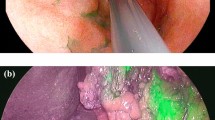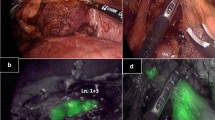Abstract
Background
Adequate lymphadenectomy during gastroesophageal junction (GEJ) cancer resection is essential, because lymph node (LN) metastasis correlates with increased recurrence risk. Fluorescence lymphography with indocyanine green (ICG) has been used for LN mapping in several surgical specialties; however, reports on GEJ cancer are lacking. Therefore, we investigated whether intraoperative ICG lymphography could facilitate LN harvest during robot-assisted resection of GEJ cancer.
Methods
Patients scheduled for robot-assisted resection of GEJ cancer were included, and outcomes were compared with historical controls. After intraoperative endoscopic submucosal ICG injection, standard D1 + LN dissection was performed under white light. Then, near-infrared (NIR) fluorescence imaging was activated, and each LN dissection area was re-examined. Any tissue within the D1 + field exhibiting distinctly increased ICG fluorescence compared with background tissue was dissected and sent for pathology review.
Results
We included 70 patients between June 2020 and October 2021. Three cases were aborted due to disseminated disease, and two were converted to open resection and excluded from the analysis. Additional tissue was dissected after NIR review in 34 of 65 (52%) patients. We dissected 43 fluorescent tissue samples, and after pathology review, 30 were confirmed LNs; none were metastatic. The median number of LNs harvested per patient (34, interquartile range [IQR] = 26–44) was not significantly different from that harvested from historical controls (32, IQR = 24–45; p = 0.92), nor were there any differences between these two groups in the duration of surgery, intraoperative blood loss, or comprehensive complication scores (p = 0.12, p = 0.46, and p = 0.41, respectively).
Conclusions
Intraoperative NIR lymphography with ICG may aid LN detection during robot-assisted resection of GEJ cancer without increasing surgical risk. Although NIR lymphography may facilitate LN dissection, none of the LN removed after the NIR review was metastatic. Hence, it remains uncertain whether NIR lymphography will improve oncological outcomes.





Similar content being viewed by others
References
Hagens ERC, van Berge Henegouwen MI, Cuesta MA, Gisbertz SS (2017) The extent of lymphadenectomy in esophageal resection for cancer should be standardized. J Thoracic Dis 9:S713–S723
Danish Esophogastric Cancer Group (2020) DEGC guidelines—Surgical treatment of esophageal cancer, including the gastroesophageal junction.
Zhang S, Orita H, Fukunaga T (2019) Current surgical treatment of esophagogastric junction adenocarcinoma. World J Gastrointest Oncol 11(8):567–578
Okholm C, Svendsen LBo, Achiam MP (2014) Status and prognosis of lymph node metastasis in patients with cardia cancer—a systematic review. Surg Oncol 23(3):140
Zhang M, Li Z, Ma Y, Zhu G, Zhang H, Xue Y (2012) Prognostic predictors of patients with carcinoma of the gastric cardia. Hepatogastroenterology 59(115):930–933
Lee YJ, Van den Berg NS, Orosco RK, Rosenthal EL, Sorger JM (2021) A narrative review of fluorescence imaging in robotic-assisted surgery. Laparosc Surg 5:31
Zeng HC, Hu JL, Bai JW, Zhang GJ (2019) Detection of sentinel lymph nodes with near-infrared imaging in malignancies. Mol Imaging Biol 21:219–227
Kwon IG, Son T, Il KH, Hyung WJ (2019) Fluorescent lymphography-guided lymphadenectomy during robotic radical gastrectomy for gastric cancer. JAMA Surg 154(2):141–149
Zhou SC, Tian YT, Wang XW, Zhao CD, Ma S, Jiang J et al (2019) Application of indocyanine green-enhanced near-infrared fluorescence-guided imaging in laparoscopic lateral pelvic lymph node dissection for middle-low rectal cancer. World J Gastroenterol 25(31):4502–4511
Zhang Y, Zhang Y, Zhu J, Tao H, Liang H, Chen Y et al (2021) Clinical application of indocyanine green fluorescence imaging in laparoscopic lymph node dissection for intrahepatic cholangiocarcinoma: a pilot study (with video). Surgery 171(6):1589–1595
Cianchi F, Indennitate G, Paoli B, Ortolani M, Lami G, Manetti N et al (2020) The Clinical value of fluorescent lymphography with indocyanine green during robotic surgery for gastric cancer: a matched cohort study. J Gastrointest Surg 24(10):2197–2203
Kim TH, Kong SH, Park JH, Son YG, Huh YJ, Suh YS et al (2018) Assessment of the completeness of lymph node dissection using near-infrared imaging with indocyanine green in laparoscopic gastrectomy for gastric cancer. J Gastric Cancer 18(2):161–171
Chen Q-Y, Xie J-W, Zhong Q, Wang J-B, Lin J-X, Lu J et al (2020) Safety and efficacy of indocyanine green tracer-guided lymph node dissection during laparoscopic radical gastrectomy in patients with gastric cancer. JAMA Surg 155(4):300–311
Kinami S, Oonishi T, Fujita J, Tomita Y, Funaki H, Fujita H et al (2016) Optimal settings and accuracy of indocyanine green fluorescence imaging for sentinel node biopsy in early gastric cancer. Oncol Lett 11(6):4055–4062
Kim MJ, Shin R, Oh H-K, Park JW, Jeong S-Y, Park J-G (2011) The impact of heavy smoking on anastomotic leakage and stricture after low anterior resection in rectal cancer patients. World J Surg 35(12):2806–2810
Lan Y-T, Huang K-H, Chen P-H, Liu C-A, Lo S-S, Wu C-W et al (2017) A pilot study of lymph node mapping with indocyanine green in robotic gastrectomy for gastric cancer. SAGE Open Med 5:1–8
Tajima Y, Murakami M, Yamazaki K, Masuda Y, Kato M, Sato A et al (2010) Sentinel node mapping guided by indocyanine green fluorescence imaging during laparoscopic surgery in gastric cancer. Oncol 17:1787–1793
Osterkamp J, Strandby RB, Nerup N, Svendsen MBS, Svendsen LB, Achiam MP (2021) Time to maximum indocyanine green fluorescence of gastric sentinel lymph nodes and feasibility of combined indocyanine green/sodium fluorescein gastric lymphography. Langenbeck’s Arch Surg 2021(1):1–8
Schlottmann F, Barbetta A, Mungo B, Lidor AO, Molena D (2017) Identification of the lymphatic drainage pattern of esophageal cancer with near-infrared fluorescent imaging. J Laparoendosc Adv Surg Tech 27(3):268–271
Society JE (2017) Japanese classification of esophageal cancer, 11th edition: part I. Esophagus 14(1):1–36
Kong SH, Marchegiani F, Soares R, Liu Y-Y, Suh YS, Lee HJ, Dallemagne B, Yang HK, Marescaux J, Diana M (2019) Fluorescence lymphangiography-guided full-thickness oncologic gastric resection. Surg Endosc 33(2):620–632
Lirosi MC, Biondi A, Ricci R (2017) Surgical anatomy of gastric lymphatic drainage. Transl Gastroenterol Hepatol. https://doi.org/10.21037/tgh.2016.12.06
Clavien PA, Barkun J, De Oliveira ML, Vauthey JN, Dindo D, Schulick RD et al (2009) The clavien-dindo classification of surgical complications: five-year experience. Ann Surg 250(2):187–196
Slankamenac K, Nederlof N, Pessaux P, De Jonge J, Wijnhoven BPL, Breitenstein S et al (2014) The comprehensive complication index: a novel and more sensitive endpoint for assessing outcome and reducing sample size in randomized controlled trials. Ann Surg 260(5):757–763
Kim TH, Suh YS, Huh YJ, Son YG, Park JH, Yang JY et al (2018) The comprehensive complication index (CCI) is a more sensitive complication index than the conventional Clavien-Dindo classification in radical gastric cancer surgery. Gastric Cancer 21(1):171–181
Zhang C, Wu Q-C, Hou P-Y, Zhang M, Li Q, Jiang Y-J et al (2011) Impact of the method of reconstruction after oncologic oesophagectomy on quality of life — a prospective, randomised study. Eur J Cardio-Thoracic Surg 39(1):109–114
Levinson KL, Mahdi H, Escobar PF (2013) Feasibility and optimal dosage of indocyanine green fluorescence for sentinel lymph node detection using robotic single-site instrumentation: preclinical study. J Minim Invasive Gynecol 20(5):691–696
Miwa K, Kinami S, Taniguchi K, Fushida S, Fujimura T, Nonomura A (2003) Mapping sentinel nodes in patients with early-stage gastric carcinoma. Br J Surg 90(2):178–182
Brierley JD, Gospodarowicz MK, UICC (2016) TNM classification of malignant tumours, 8th edn. Union Int Cancer Control, Geneva
Mulcahy HE, Kelly P, Banks MR, Connor P, Patchet SE, Farthing MJG et al (2001) Factors associated with tolerance to, and discomfort with, unsedated diagnostic gastroscopy. Scand J Gastroenterol 36(12):1352–1357
Ben-Menachem T, Decker GA, Early DS, Evans J, Fanelli RD, Fisher DA et al (2012) Adverse events of upper GI endoscopy. Gastrointest Endosc 76(4):707–718
Bischoff PM, Niederberger HJ, Török B, Speiser P (1995) Simultaneous indocyanine green and fluorescein angiography. Retina 15(2):91–99
Meershoek P, KleinJan GH, van Willigen DM, Bauwens KP, Spa SJ, van Beurden F et al (2021) Multi-wavelength fluorescence imaging with a da Vinci Firefly—a technical look behind the scenes. J Robot Surg 15(5):751–760
Lütken CD, Fiehn AMK, Federspiel B, Achiam MP (2019) Impact of isolated tumor cells in regional lymph nodes in adeno-and squamous cell carcinoma of the esophagus and the esophagogastric junction—A systematic review. Pathol Res Pract 215(5):849–854
Hartgrink HH, Jansen EP, van Grieken NC, van de Velde CJ (2009) Gastric cancer. Lancet (London, England) 374(9688):477
Juhl K, Christensen A, Persson M, Ploug M, Kjaer A (2016) Peptide-based optical uPAR imaging for surgery: in vivo TESTING of ICG-Glu-Glu- AE105. PLoS ONE 11(2):e0147428
Acknowledgements
The authors sincerely thank all participating surgeons, anesthesiologists, and nurses from the Surgical Gastroenterology and Anesthesia departments at Rigshospitalet, Copenhagen for their most valuable contributions.
Funding
The corresponding author received funding from Medtronic plc (Grant: OPI-projekt), Grosserer L.F. Foghts Fond (Grant Number: 21807), Fabrikant Einar Willumsens Mindelegat (Grant Number: 500028) and Aase og Ejnar Danielsens Fond (No grant number was provided).
Author information
Authors and Affiliations
Corresponding author
Ethics declarations
Disclosures
Jens Osterkamp received funding from Medtronic plc (Grant: OPI-projekt), Grosserer L.F. Foghts Fond (Grant Number: 21807), Fabrikant Einar Willumsens Mindelegat (Grant Number: 500028), and Aase og Ejnar Danielsens Fond (No Grant Number was provided). Rune Strandby, Nikolaj Nerup, Morten Bo Søndergaard Svendsen, Lars Svendsen, and Michael P. Achiam have no conflicts of interest or financial ties to disclose.
Ethical approval
The study was approved by the Danish Committee on Health Research Ethics (ID: H-19041735) and registered at clinicaltrials.gov (ID: NCT04107623). Approval to retrieve and compare data from historical controls was received from the Centre of Regional Development, Capital Region of Denmark (R-21049798).
Additional information
Publisher's Note
Springer Nature remains neutral with regard to jurisdictional claims in published maps and institutional affiliations.
Rights and permissions
Springer Nature or its licensor holds exclusive rights to this article under a publishing agreement with the author(s) or other rightsholder(s); author self-archiving of the accepted manuscript version of this article is solely governed by the terms of such publishing agreement and applicable law.
About this article
Cite this article
Osterkamp, J., Strandby, R., Nerup, N. et al. Intraoperative near-infrared lymphography with indocyanine green may aid lymph node dissection during robot-assisted resection of gastroesophageal junction cancer. Surg Endosc 37, 1985–1993 (2023). https://doi.org/10.1007/s00464-022-09684-y
Received:
Accepted:
Published:
Issue Date:
DOI: https://doi.org/10.1007/s00464-022-09684-y




